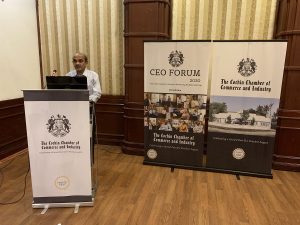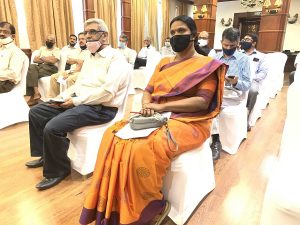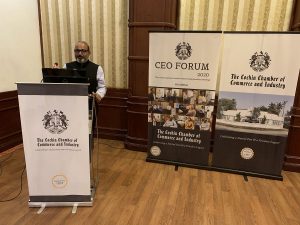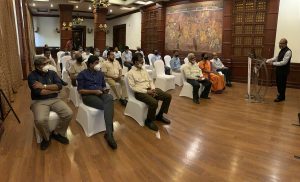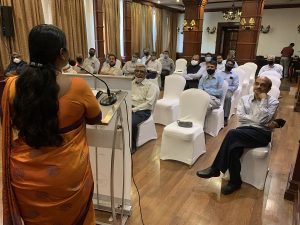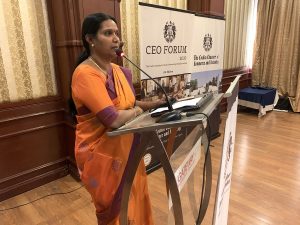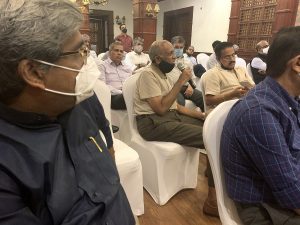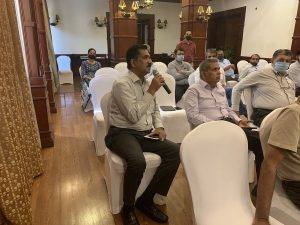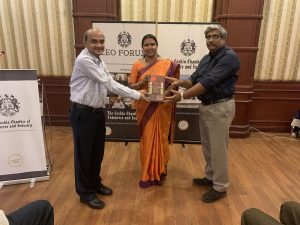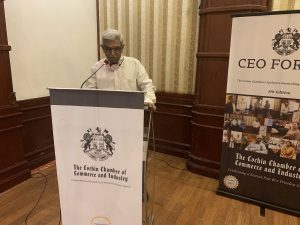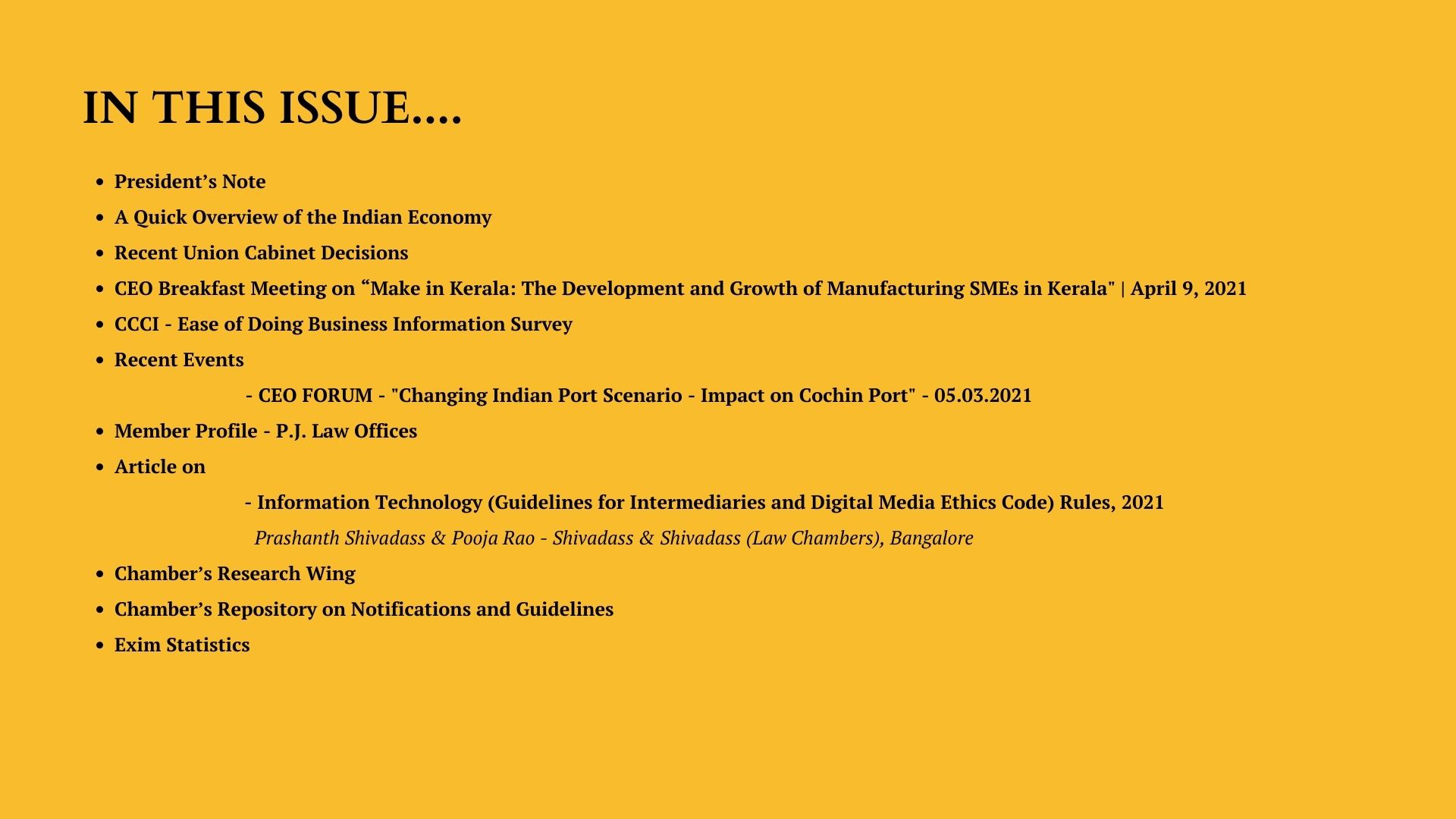
President's Note
Dear Members,
Greetings of the season to you all!
The month of March marked the first anniversary of the nationwide lockdown provoked by the Covid-19 pandemic. The economic impact of the lockdown and its aftermath were huge but thankfully India has been able to withstand and come out of this unexpected situation quite well. Formal approaches to predicting the Indian economy’s growth path may not always account for the innate resilience, innovativeness and adaptability of the country’s citizenry, especially in the informal sector. India has the ability to surprise, by exceeding carefully

constructed growth projections. If we are to benefit from our innate strengths in terms of workforce capabilities, cost advantages and the strength of our domestic market, we need to induce greater efficiencies into other areas like ease of doing business and access to markets.
All told, the economy looks well set on its pathway to recovery and revival, and the roadmap that the government is charting, particularly in terms of the well-received recent budget have made the right moves towards this end.
Now that the vaccine rollout has commenced, we need to plan for the economic pathway ahead, not just in terms of a revival to a steeper growth trajectory, but also by imbibing the learnings that the pandemic has brought home to us. Hopefully, one of the durable legacies of this pandemic is the universal realisation that individuals, institutions and firms – all need to ground their planning on a bedrock of sustainability, with adequate care given to considerations of being better aligned with the physical and social environment.
Kerala is on the threshold of the State Assembly elections and we in the Chamber hope that we will have a Government that is business friendly and will be committed to the reform agenda for the furtherance of the ease of doing business in the State.
In this regard, we have made representations to the different political fronts outlining what we think are the steps essential to promote Kerala as a business-friendly destination.
Our suggestions include bringing in a new Industrial Policy that promotes the industrial competitiveness of Kerala. Initiating ease of doing business reforms by providing for compliance relaxation for industries namely by providing relief under various heads like property tax, rent, cess, electricity tariff etc. that are directly under the purview of the state government. Another important requirement is a Kerala export policy/ export promotion policy to promote exports from the State. We have also asked for a comprehensive Retail Trade Policy for Kerala to promote the retail sector.
A logistics policy highlighting the Government’s vision in facilitating an end to end logistics support system in place of trading through multi-directional approach for storage, distribution, transportation, ancillary support services, trade facilitation etc. Kerala needs an ecosystem for MSME revival and also facilitate innovation as a policy priority. We also need to promote sustainable competitive tourism by re-visiting the tourism framework. We hope that the new Government will look into these issues on a priority basis.
The final session of the 5th edition of the CEO FORUM meetings was held on the 12th of March. I am happy to say that the address delivered by our Guest Speaker, Chairperson of the Cochin Port, Dr. M. Beena IAS was well received. Dr. Beena spoke on the topic “Changing Indian Port Scenario – Impact on Cochin Port.” A detailed report on this session is carried in the newsletter.
The 6th edition of the CEO FORUM Breakfast meetings is scheduled to begin on the 9th of April. Mr. C. Balagopal, Former M.D. & Founder, Terumo Penpol Ltd. and Independent Director, The Federal Bank Ltd. has agreed to address the inaugural session of the 6th edition of the CEO FORUM Breakfast meetings. Mr. Balagopal quit his I.A.S. to become an entrepreneur in Kerala and is a strong advocate of “Invest in Kerala” initiative. He believes that our state gives ample opportunities for investment and has more than 50 cases to quote on successful entrepreneurship originated from the State.
I hope you will all take this opportunity to join this exclusive group of CEO’s to benefit from this monthly networking exercise.
I wish you all and your families, happy holidays and a great Easter weekend.
Harikumar
President
Quote

Fine Points
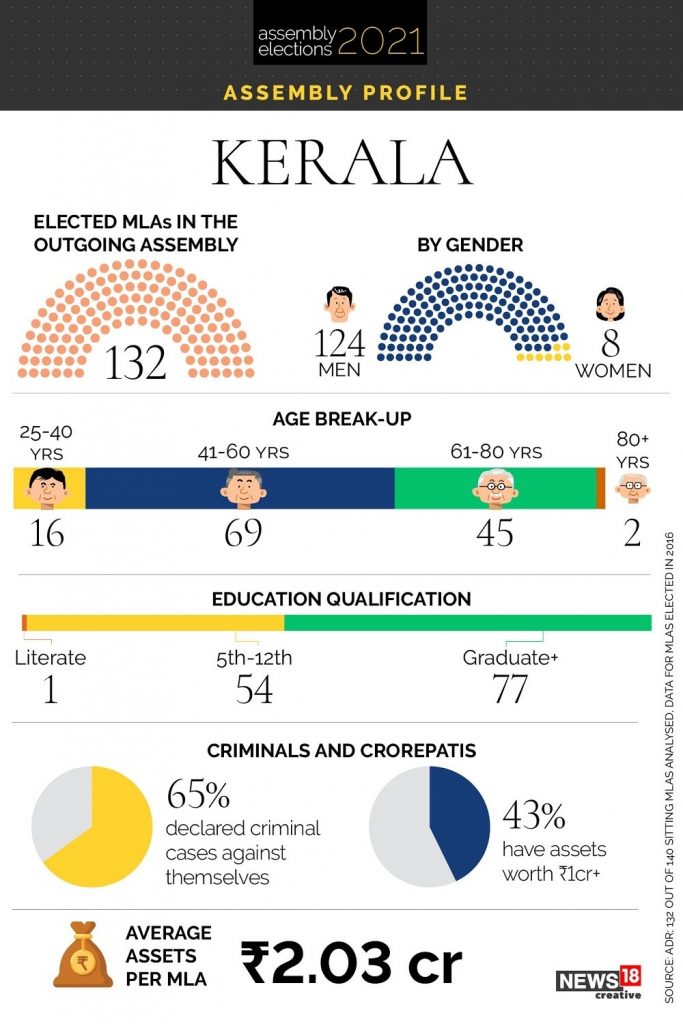
A Quick Overview of the Indian Economy
Lockdown anniversary: Worst behind, Indian economy poised for bounce back but rising Covid-19 cases a big risk
Its recovery from the depths of the lockdown-induced recession was swifter than expected but a surge in coronavirus cases is threatening to hurt the Indian economy which is expected to grow at 11 per cent in 2021-22. Exactly a year back, the government imposed what is touted as the world’s most stringent lockdown to contain the spread of the pandemic. The lockdown brought the economy to a halt as factories were shut, trains were stopped and flights were suspended.
This sent the economy into its worst-ever contraction of 24.4 per cent in the June quarter, followed by a -7.3 per cent shrinkage in July-September, pushing the economy into a rare recession.
However, the economy’s rebound was better than expected, with GDP surpassing its pre-pandemic level in the December quarter, growing 0.4 per cent year-on-year.
The rebound led to ministers predicting a sharp ‘V-shaped’ recovery.
But the surge in coronavirus cases, despite the rollout of a nationwide vaccination drive, in recent weeks could hurt the recovery.
Unlike other COVID-hit regions like Europe, India has so far been reluctant to impose any more harsh restrictions.
In many countries including India, second or third COVID wave has led to partial or localised lockdowns delaying the pace of recovery, said D K Srivastava, Chief Policy Advisor, EY India.

“It is the rate at which the population gets a vaccination cover, which will determine the performance of the economy in FY22. Fortunately, for India, the rate of vaccination is gathering momentum and a strong growth supporting fiscal policy has also been put in place through Centre’s FY22 budget. The expectation is that India would show one of the largest bounce backs in the growth rate in FY22,” he said.
Echoing similar views, ICRA Principal Economist Aditi Nayar said “COVID-19 infection counts have risen in many Indian states in recent weeks, spurring fresh localised restrictions. If this trend proliferates, it would temper the extent of the base effect-led recovery anticipated in the immediate term, and may lead to some supply-side disruptions.”
At this point, business confidence is improving significantly and it seems that we will be on track towards growth despite COVID and businesses have realised that we must learn to live with COVID and its impact as we fuel the economy for growth, said L Viswanathan, Partner at Cyril Amarchand Mangaldas.
To mitigate the impact of COVID-19 pandemic on the economy, the government and the RBI came out with a series of packages in a phased manner totalling around Rs 30 lakh crore or 15 per cent of India’s GDP.
Steps taken by the government to deal with COVID pandemic are resulting in a ‘V-shaped’ economic recovery and the country is likely to witness double digit growth in 2021-22, Minister of State for Finance Anurag Singh Thakur said in Lok Sabha last week.
He said the government focused on saving lives during the pandemic without bothering about the fiscal deficit.
In the next fiscal, the Budget has earmarked Rs 35,000 crore for vaccination and the government has assured to provide more if needed.
“The GST collection in the last five months was continuously more than Rs one lakh crore… Because of the steps taken by the government during COVID-19, V-shaped economic recovery is happening. And world over, agencies have stated India will witness double digit growth in 2021-22,” he had said.
Soon after the pandemic hit the country, the government in March 2020 announced a Rs 1.70 lakh crore Pradhan Mantri Garib Kalyan Yojana (PMGKY) to protect the poor and vulnerable from the impact of health crisis and lockdown. Other relief measures were to the tune of Rs 22,000 crore.
It was followed by the Aatmanirbhar Bharat Abhiyan package in May 2020 largely focussed on supply-side measures and long term reforms. The five-part stimulus package announced by Finance Minister Nirmala Sitharaman beginning May 13, 2020 comprised Rs 5.94 lakh crore in the first tranche that provided credit line to small businesses and support to shadow banks and electricity distribution companies.
The second tranche included free foodgrain for stranded migrant workers for two months and credit to farmers, totalling Rs 3.10 lakh crore. Spending on agri infrastructure and other measures for agriculture and allied sectors in the third tranche totalled to Rs 1.5 lakh crore.
The fourth and fifth tranches that dealt mostly with structural reforms, including relaxation of Foreign Direct Investment (FDI) limit in defence, privatisation of six more airports, and fully opening up coal mining to the private sector.
To boost consumption during the festival season, the government October, 2020 announced measures of close to Rs 73,000 crore to stimulate consumer spending in an effort to rein in slowdown due to the COVID-19 pandemic.
Aatmanirbhar Bharat Abhiyan 3.0 unveiled in November 2020, ahead of Diwali, was Rs 2.65 lakh crore. Of the total, the maximum of Rs 1.45 lakh crore was allocated to give a boost to manufacturing, followed by Rs 65,000 crore for agriculture (fertiliser subsidy), and Rs 10,200 crore for industrial infrastructure, incentives and domestic defence equipment.
On its part, RBI made liquidity infusion to the tune of Rs 12,71,200 crore into the Indian economy battered by COVID-19 pandemic till October 2020.
All the stimulus measures since March 2020 by the Centre and Reserve Bank of India put together were to the tune of Rs 29,87,641 crore.
As a result of all these measures and decline in COVID infection, the economy is showing green shoots and a positive growth of 0.4 per cent in the third quarter of the ongoing financial year is an indication of rebound. However, the economy in the current year is estimated to contract by 8 per cent on account of the COVID pandemic.
Source: Click here
Recent Union Cabinet Decisions
- Cabinet approves signing of an MoU between Union Public Service Commission, India and Independent Administrative Reforms and Civil Services Commission, Afghanistan – 23 Mar 2021
- Cabinet apprised on progress under National Health Mission (NHM) 2019-20 – 23 Mar 2021
- Cabinet approves Memorandum of Cooperation (MoC) signed between India and Japan in the field of Water Resources – 23 Mar 2021
- Cabinet approves MoU between India and Maldives on Cooperation in Sports and Youth Affairs – 16 Mar 2021
- Cabinet approves closure of Handicrafts and Handlooms Export Corporation of India Limited – 16 Mar 2021
- Cabinet approves creation of Pradhan Mantri Swasthya Suraksha Nidhi as a single non-lapsable reserve fund for Health from the proceeds of health and Education Cess – 10 Mar 2021
- Cabinet approves Memorandum of Understanding between India and Fiji for cooperation in the field of Agriculture and Allied Sectors – 03 Mar 2021
- Cabinet approves Memorandum of Understanding between India and France on Renewable Energy Cooperation – 03 Mar 2021
Forthcoming Event
CEO FORUM 2021 - 6th Edition Inaugural Session
Make in Kerala: The Development and Growth of Manufacturing SMEs in Kerala - 09.04.2021
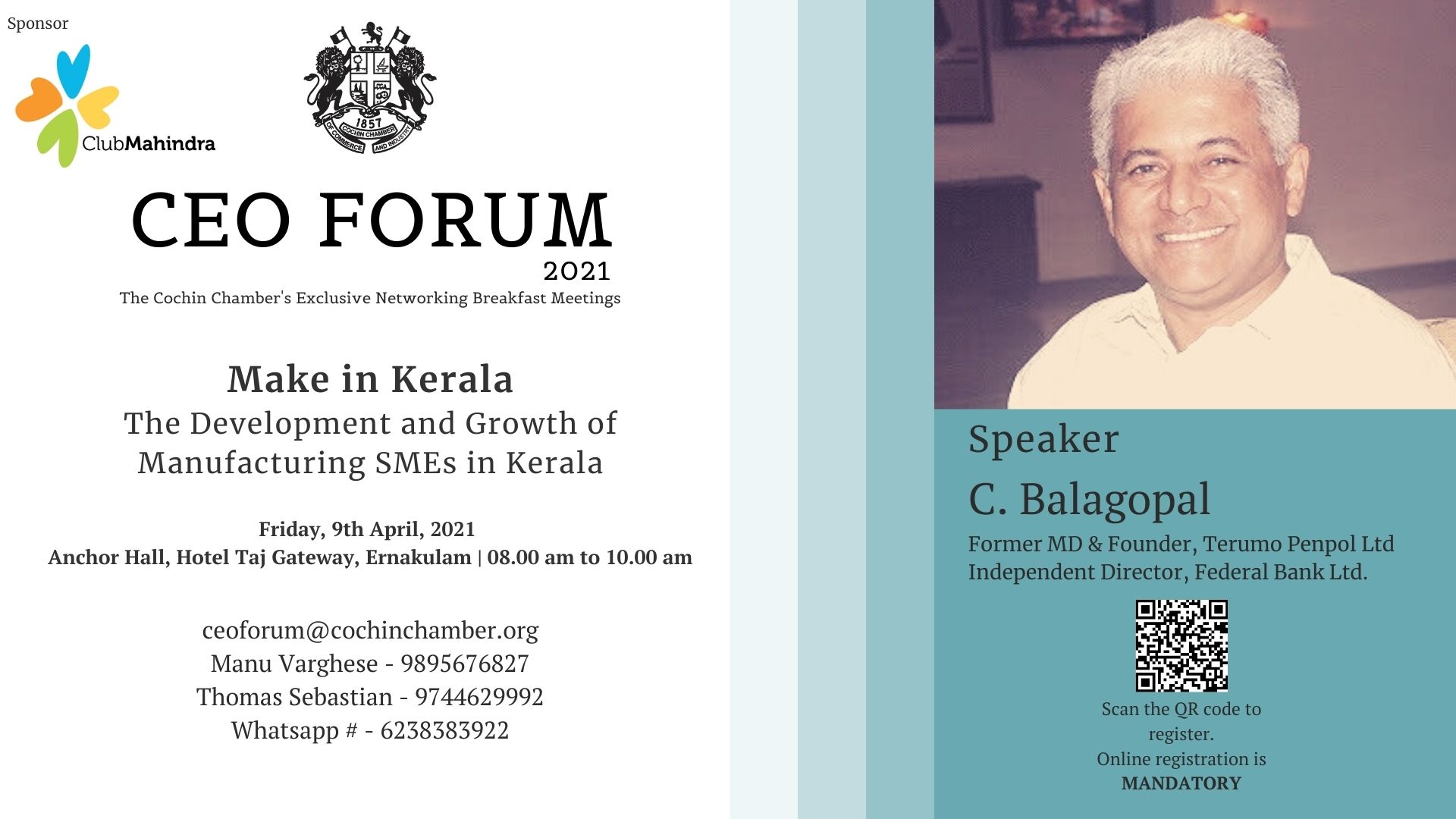
The Inaugural session of the 6th edition of the CEO FORUM Breakfast Meetings is scheduled for Friday, the 9th of April, 2021. The meeting will be held at the Anchor Hall, Hotel Taj Gateway, Ernakulam between 08.00hrs and 10.00hrs.
Mr. C. Balagopal, Former MD & Founder, Terumo Penpol Ltd, and Independent Director, Federal Bank Ltd. has graciously agreed to be the Guest Speaker for the upcoming meeting. He will speak on “Make in Kerala: The Development and Growth of Manufacturing SMEs in Kerala”
Shri. Balagopal who quit IAS to become an entrepreneur in Kerala is a strong advocate of “Invest in Kerala.” He believes that Kerala gives ample opportunities for investment and has more than 50 cases to quote on successful entrepreneurship originated from the state. An independent thinker, who does not go by the public perception, will kindle the thoughts of entrepreneurship in every one of you.
Rest assured that all safety measures will be adhered to in the conduct of the meeting. Wearing of Masks and maintaining Social Distance is mandatory. As this is the first session in the 2021 edition, it is mandatory to register for the event upfront.
We look forward to your participation and thank you in advance for the same. Kindly do register for the event.
Click here to register
CCCI - Ease of Doing Business Information Survey
The Kerala Government has constituted a Committee of Secretaries vide Order dated 7th October 2020 as Phase 1 of exercising minimum regulatory compliance on businesses. The Cochin Chamber of Commerce & Industry wishes to contribute quality policy inputs to the Government to improve Ease of Doing Business in the State.
Questionnaire on Business Information Survey (click on the link given to view the same)
We request you to send your valuable inputs by filling the above Questionnaire and kindly co-operate with us.
Recent Event
CEO FORUM 2021 - 5th Edition Last Session
Changing Indian Port Scenario - Impact on Cochin Port - 05.03.2021
The last session of the 5th edition of the CEO FORUM Breakfast Meeting was held on Friday the 12th of February, 2021. Dr. M. Beena I.A.S, the Chairperson of the Cochin Port trust was the Guest Speaker at this Session.
Mr. K. Harikumar, President of the Cochin Chamber of Commerce & Industry delivered the Welcome Address and introduced Dr. Beena to the CEOs of the Forum. Mr. Harikumar also briefly outlined the activities of the Chamber during the past month.
Adv. P.M. Prabhakaran of Lakshmi Kumaran & Sridharan, Bangalore, a new member of the Chamber was invited to address the Forum and introduce himself and the organization he represents. Adv. Prabhakaran thanked the Chamber for the opportunity and spoke briefly about his firm.
Dr. Beena commenced her address by thanking the Cochin Chamber and Mr. C.S. Kartha, Executive Committee Member of the Chamber, for inviting her to be the Guest Speaker for this session. Dr. Beena called the group of CEOs present at the session a group of power-packed people with heritage. She thanked the President for the excellent introductory address and said that he had touched upon most of the topics she wished to speak about.
Dr. Beena said that the Cochin Port is one of the 12 Major Ports in India. The concept of Major and Minor Ports are slightly confusing, as there are Ports like the Mudra Port which is not a Minor Port but nevertheless it is called a Minor Port because it does not belong to the Major Ports Club. The Ports that belong to the Major Ports Club are the old ones and they are all controlled by the Central Government. The Minor Ports are ports controlled by State Governments, she said. As of now, in India, there are 12 Major Ports and 205 odd non-major Ports, which together cater to 95% of India’s trade by volume and 75% by value.
Dr. Beena then gave a brief introduction as to how Cochin Port is doing. She explained, that the Cochin Port in terms of cargo volume, handles around 5% of the total Indian Cargo. However, the Cochin Port has been steadily increasing the Cargo volumes it has been handling for the last 4 years consistently. The Cochin Port, in total, handled 34 million metric tons of cargo last year which was an increase from the 31 million metric tons and 25 million metric tons of cargo which the Cochin Port handled during the previous years. Last year when the Port handled 34 million metric tons of cargo, the Cochin Port was the 2nd fastest-growing Port in India, she said. This year, due to the Covid-19 pandemic, there has been a huge dip in the volume of cargo handled by the port, especially during the first 4 months. Dr. Beena said, in spite of the crisis, there has been a steady increase in trade during the last couple of months.
The most promising thing we see now in terms of trade is the movement of containers, which for the past 3 months, has been crossing 70,000 which is a record in the Cochin Port, she said. Dr. Beena also emphasized that the Cochin Port has a very good Port management system and in terms of efficiency, the Cochin Port is right up there with its competitors, if not the best in India. The next point where the Port activities get quantitatively compared is the turnaround time of ships, and the Cochin Port excels in this by having the shortest turnaround time in all of the 12 Major Ports in India.
Dr. Beena later spoke about the Major Port Trust Act, which is now being changed to Major Port Authorities like in other countries. She then explained the main differences between the TAMP (Tariff Authority) which fixes the rates in all the Major Ports and the new Act which replaces it.
A few of the more important MOUs signed by the Cochin Port recently were also highlighted by Dr. Beena. MOUs signed between the Cochin Port and IGTPL for a FTWZ, Cryogenic Warehouse at Puthu Vypin SEZ, ICD services between Kottayam Port and the Cochin Port for inland cargo movement, MOUs signed with cement companies, etc. were also explained in detail by Dr. Beena. She also said that a variety of new facilities and projects are coming up in conjunction with the Cochin Port and informed the meeting that a total of 27 MOUs have been signed to the tune of Rs. 3313 crores.
One of the more important developments that the Cochin Port wants to highlight is the Vision of the Port Authority to develop and bring investments to port lands. Dr. Beena welcomed proposals for hospitals and other infrastructural investments to promote the tourism sector etc. to the Cochin Port in her address.
Concluding her address, Dr. Beena said that the Cochin Port has officially received funds for the development of the Thopumpady Fisheries Hub which has been neglected for a very long time. She encouraged everyone in the forum to come up with ideas and proposals and discuss the same with her, for the benefit of trade and industry and the Cochin Port.
The address by Dr. Beena was followed up by a variety of questions from the CEOs at the Forum.
Mr. P.M. Veeramani, Vice-President of the Cochin Chamber wound up the meeting with a Vote of Thanks.
The session was attended by around 30 CEOs.
Member Profile
PJ Law Offices

Mr. Pradeep Joy, Principal Counsel
PJ LAW OFFICES focuses on providing legal support for Corporate Restructuring, Insolvency and Bankruptcy, Fintech & Technology Communication, Corporate Litigation.
Article
The Ministry of Electronics and Information Technology (‘MEiTy’), on February 25, 2021, implanted the new ‘Information Technology (Guidelines for intermediaries and Digital Media Ethics Code) Rules, 2021 (‘IT Rules, 21’) to regulate all digital platforms like social media and Over-the-Top (‘OTT’) Platforms.
The IT Rules 21, have been framed in exercise of powers under Section 79(2)(c), Section 69A(2), Section 87(10)(z) and Section 87(2) of the Information Technology Act, 2000 (‘IT Act’) and in supersession of the earlier Information Technology (Intermediary Guidelines) Rules 2011 (‘IT Rules’).
The rules primarily focus on in-house and self-regulation mechanism in lieu of grievance redressal mechanisms while upholding journalistic conduct and creative freedom in print media and is significantly different from the erstwhile IT Rules.

Digital Platforms broadly include (i) Broadcast Seva, (ii) Content Descriptor, (iii) Digital Media, (iv) Intermediaries, (v) News and Current Affairs Content, (vi) On demand, (vii) Online Curated Content, (viii) Publisher of News and Current Affairs Content, (ix) Publisher of Online Curated Content, (x) Social Media Intermediaries, and (xi) Significant Social Media Intermediaries. Each of these terms have been defined in Rule 2 of the IT Rules, 21.
With the widespread use of smartphones, lightning-fast internet facilities and ever changing technology, the digital platforms have expanded their bandwidth in India over the past decade. Amongst various social media platforms, WhatsApp, YouTube, Facebook, Instagram and Twitter users account for 53 crores, 44.8 crores, 41 crores, 21 crores and 1.75 crores, respectively. Amongst OTT platforms, a market reach of 42.50 billion was seen in Financial Year 2019, in India.
The basic framework to determine intermediary liability is provided under Section 79 of the IT Act, which was supplemented by operational rules and the Supreme Court’s judgment in Shreya Singhal v. Union of India. The framework took further shape with the judgement of Prajjawala v. Union of India, wherein the Supreme Court, in a suo-moto Writ Petition observed that there is a requirement for framing necessary guidelines to eliminate child pornography, rape and gangrape imageries, videos and sites in content hosting platforms and other applications. The Supreme Court also directed MEiTY to take necessary steps to introduce IT Rules.
The IT Rules, 21, are applicable to ‘users’ which is defined under Rule 2(aa) as “any person who accesses or avails any computer resource of an intermediary or a publisher for the purpose of hosting, publishing, sharing, transacting, viewing, displaying, downloading or uploading information and includes other persons jointly participating in using such computer resource and includes addressee and originator.”
The IT Rules, 21, are focussed more on grievance redressal, self-check mechanisms and due diligences to followed by all. In light of the increasing usage of OTT and other like platforms, there have been growing concerns about their regulation and their control. Several discussions have ensued between the industry and Government in so far as content regulation is concerned which has resulted in the present IT Rules, 21.
DUE DILIGENCE TO BE FOLLOWED BY INTERMEDIARIES
While the IT Rules, 2011, also had due-diligence and other compliances to be followed by Intermediaries, the IT Rules 21, now provide for an increased due diligence and compliance, for all activities. This due diligence is applicable to all intermediaries including social media intermediary and significant social media intermediary.
A) An intermediary must ‘prominently publish’ on its website or application applicable rules and regulations, privacy policy and user agreement for access or usage of its computer resource by any person;
B) Given that the proposed Personal Data Protection Bill, 2019 (‘PDP Bill 19’) is on cards, the guidelines relating to hosting, displaying, modifying, publishing, transmitting, storing etc., through rules and regulations, privacy policy and user agreements, have been retained. The only addition is that “any information that patently false and untrue, and is written or published in any form, with the intent to mislead or harass a person, entity or agency for financial gain or to cause any injury to any person”, has been added to the such a list.
C) There is also an additional obligation that has now been placed on an intermediary to inform its users once every year, in case of non-compliance with rules and regulations, privacy policy and user agreement, that it has a right to terminate the access or usage rights of such users immediately, or remove any objectionable or non-compliant material.
D) If the intermediary is within knowledge that a Court order or Notification exists, preventing such intermediary from hosting, storing or publishing such information (which is otherwise prohibited by law), the intermediary must immediately bring down such content or information within 36 hours from the date of the Order or Notification. However, any information that has been voluntarily brought down by the intermediary, pursuant to a grievance, shall not be covered under the ambit of Section 79(2)(b) of the IT Act.
E) Additionally, once the intermediary receives a Court order or a Notification from the Government, must provide all of the information under its possession, within 72 hours for the purposes of carrying on any investigations.
F) If the intermediary is in receipt of any complaint from any user and basis such a complaint, the intermediary has infact removed such objectionable material from a website or an application, the intermediary must store such records for a period of 180 days for investigative purposes or any other time as prescribed by a Court or the Government. Additionally, if the intermediary collects information from a ‘user’ for registration on a computer resource, it must retain such information for 180 days for the purposes of investigation (if any), after cancellation of such registration.
G) The intermediary must now ‘prominently publish’, on its website or application or both, the name of the ‘Grievance Officer’ and their contact details as well as the detailed mechanism by which a user or a victim can make complaints against violation of provisions or matters pertaining to computer resources made available by it. The Grievance Officer shall thereafter be responsible for the following:
1) Acknowledging the complaint within three (3) working days and resolving it within one (1) month from the date of receipt;
2) Receipt and acknowledgement of any order, notice or direction issued by the appropriate government, any competent authority or a court of competent jurisdiction
H) In case of data in the nature of non-consensual transmission of any material which exposes the private area of any person, shows a person in full or partial nudity or shows or depicts such person in any sexual act or conduct, or in the nature of impersonation in an electronic form including artificially morphed images especially if such content is transmitted with the intent to harass, intimidate threaten or abuse an individual, the intermediary is obligated to, within 24 hours from receipt of a complaint made under Rule 4, take all reasonable and practicable measures to remove or disable access to such content.
ADDITIONAL DUE DILIGENCE TO BE CARRIED OUT BY SIGNIFICANT SOCIAL MEDIA INTERMEDIARY
The IT Rules, 21, now imposes additional due diligence to be carried out by significant social media intermediaries. These additional obligations however, will take effect after 3 months from the date of issue of IT Rules, 21.
A) Appoint a Chief Compliance Officer who is responsible for ensuring compliance with the IT Act and IT Rules, 21 and will be liable for any proceedings relating to any relevant third-party information, data or communication link made available or hosts by that intermediary, where he fails to ensure that such intermediary observes due diligence while discharging its duties. However, no liability shall be imposed on significant social media intermediary without being given an opportunity of being heard.
B) Appointment of Nodal Contact Person who is available 24×7 for coordinating with law enforcement agencies. The Nodal Person must be an employee of an intermediary.
C) Appointment of Resident Grievance Officer who shall be responsible for acting upon the functions mentioned hereinbefore which provides for the Grievance Redressal Mechanism. Once again, the Resident Grievance Officer shall be an employee of the intermediary.
D) Publishing a periodic compliance report, every six months mentioning details of complaints received and action taken and the contents that have been removed by the intermediary.
E) A significant social media intermediary providing services primarily in the nature of messaging, must enable identification of the first originator of the information on its computer resource if an Order is passed by a competent Court under Section 69 of the IT Act.
F) A significant social media intermediary that provides services with respect to transmitting information on behalf of another person (a) for direct financial benefit to increase visibility and prominence or targets the receiver of that information or (b) to which it owns copyright and has exclusive licence or has entered into a contract that directly or indirectly restricts publication or transmission of that information through means other than a computer resource, must make that information clearly identifiable to its users as ‘being advertised’, marketed, sponsored, owned or exclusively controlled.
G) A significant social media intermediary must deploy ‘technology-based measures’ including automated tools to identify information that depicts any sexual act depicting rape, child sexual abuse (implicit or explicit) or to identify any information that has been previously removed but has now been given access. Such a tool must however bear in mind privacy rights and right to freedom of speech and expression.
H) The significant social media intermediary must have a physical contact address in India published on its website / mobile based application or both for all communication purposes.
I) A significant social media intermediary must enable users to verify their accounts using their Indian phone numbers (for users in India accessing accounts outside India). Where a user volunteers such information, the intermediary shall publish a visible mark of such verification to all other users.
J) When a significant social media intermediary removes or disables access to any information or data, it must ensure:
- That prior to removal, it gives adequate notice with reasons to the user, for removal of such content;
- That the originator of such content is provided with adequate opportunity to dispute the action being taken by the intermediary and request for re-instatement of access to such information;
- That the Resident Grievance Officer of such intermediary maintains appropriate oversight over the mechanism for resolution of any disputes raised above;
- That the action of the intermediary is after due consideration of the above;
- Display a notice to any other user, trying to access such disabled information about the reasons for such removal of content
CODE OF ETHICS AND PROCEDURE AND SAFEGUARDS FOR DIGITAL / ONLINE MEDIA
A newly introduced segment, the Code of Ethics is a self-regulated procedure for all ‘applicable entities’. Applicable entity means (i) publishers of news and current affairs content, (ii) intermediaries which primarily enable the transmission of news and current affairs content persons or entities, (iii) publishers of online curated content, (iv) intermediaries which primarily enable the transmission of online curated content
The self – regulated code also applies to entities which, although not primarily involved in transmission of news and current affairs content or online curated content, provide a dedicated interface for such purposes. The code applies to all entities that operate in India or cater to audiences in India.
The Code has been divided into three (3) levels:
a) Level I: Self-Regulation Mechanism
b) Level II: Self- Regulation Mechanism
C) Level III: Oversight Mechanism
We have ventured to elaborate on the same below.
At the outset, the MEitY must establish an online portal to address grievances of users. All persons having any kind of grievances regarding online content, can register the same in the said portal. An acknowledgement shall be generated and issued within 24 hours from the date of filing of grievance. Grievances shall be addressed as under:
1) The applicable entity must address the grievance and inform the complainant of its decision within 15 days from the date of registration of the grievance and forward said decision on the grievance portal;
2) If a decision is not reached within 15 days, the complaint will be escalated to the level of the self-regulating body of the entity;
3) When the complainant is not satisfied with the decision of the entity, it may prefer an appeal on the portal to the self-regulating body of which such entity is a member within 15 days of receiving such decision;
4) The self-regulating body must address the grievance (appeal above), and convey its decision in the form of a guidelines / advisory to the applicable entity, and convey its decision to the complainant within 15 days and the said decision must also be recorded in the grievance portal;
5) Where the complainant is not satisfied with the decision of the self-regulating body, it may within 15 days, prefer an appeal on the portal to the ‘Oversight Mechanism’ for resolution.
LEVEL I: SELF-REGULATION MECHANISM
Rule 10 of the IT Rules, 21, imposes an obligation on applicable entities to establish grievance redressal mechanism presided by a grievance redressal officer and set-up a grievance portal and display and easy access to the contact details on the website.
a) Grievance Redressal Officers shall be appointed for receiving any grievance relating to the Code of Ethics. He/ She shall be appointed to act as a nodal point for interaction with the complainant, the self-regulating body and the Ministry. He/ She shall take a decision within 15 days of the registration of the complaint in the grievance portal. If the complaint is related to the Code of Ethics other than the grievance portal, then the time period is constrained to 48 hours.
b) Classification of Content shall be based on themes and messages: Violence, nudity, sex, language, drug and substance abuse and horror as described in the Schedule to the IT Rules. An applicable entity shall classify all content that is transmitted/ published/ exhibited based on the nature and type of the content in the following categories-
- “U” rating for online curated content which is suitable for children as well as people of all ages;
- “U/A 7+” rating for content that is suitable for persons aged 7years and above, and can be viewed by a person under the age of 7 years with parental guidance;
- “U/A 13+” rating suitable for persons aged above 13 years, and can be viewed by persons under the age of 13 years with parental guidance;
- “U/A 16+” rating for content that is suitable for persons aged 16 years and above, and can be viewed by persons below the age of 16, but with parental guidance;
- “A” rating for the content which is restricted to adults
LEVEL II: SELF REGULATING MECHANISM
A self-regulating body (‘SRB’) shall be registered with the Ministry of Information and Broadcasting and shall oversee the adherence by the publisher to the Code of Ethics and addresses grievances that have not been resolved by the publisher within 15 days. This shall be headed by a retired Judge of the Supreme Court or High Court, who shall be appointed by the Ministry and other members from the field of media, broadcasting, technology and entertainment.
Powers of Self Regulating Body:
1) Where the SRB is satisfied that there is a need for taking action in relation to Section 69 A of the IT Act, such content must be referred to the Oversight Mechanism (Level III) under Rule 12 of the IT Rules, 21.
2) If the SRB is of the opinion that there is no violation of Code of Ethics, them the same shall be conveyed to the complainant and the applicable entity, which must be subsequently recorded in the grievance portal.
3) In case the entity fails to comply with the guidance or advisories of the SRB within the stipulated time, then the matter shall be referred to as per Rule 12 of the IT Rules, 21, within 15 days of the expiry of the stipulated date.
Guidance or Advisories to be issued by SRB:
A) Warning, censuring, admonishing or reprimanding such entity; or
B) Requiring an apology by such entity; or
C) Requiring such entity to include a warning card or a disclaimer; or
D) In case of online curated content, direct such entity to:
- Reclassify ratings of relevant content;
- Make appropriate modification in the content descriptor, age classification and access control measures;
- Edit synopsis of relevant content
LEVEL III: OVERSIGHT MECHANISM
Essentially, the Oversight Mechanism, is an overarching tool to ensure that applicable entities adhere to the code of ethics above. This mechanism has the following functions:
- Publish a charter for self-regulating bodies, including Codes of Practices for such bodies;
- Develop the Grievance Portal for prompt disposal of the grievance;
- Establish an inter-departmental committee for hearing grievance;
- Refer to the committee in point (3) above, grievances arising out of the self-regulating body or where no decision has been taken by the self-regulating body within a specific time period;
- Issue appropriate guidance and advisories for maintenance and adherence to the Code of Ethics.
Inter-Departmental Committee
MEitY has now been casted with the responsibility to formulate an Inter Departmental Committee (‘Committee’) which will consist of representatives from the Ministry of Information and Broadcasting, the Ministry of Electronics and Information Technology, Ministry of External Affairs, Ministry of Defence, Indian Computer Emergency Response Team and various other organisations.
The role of the Committee is to hear complaints regarding violation or contraventions of the Code of ethics arising out of grievances taken at Level I or II, which includes those decisions not being heard within a stipulated time or any suo moto matters or any matters referred by the Ministry.
Powers of the Inter-Departmental Committee
The Committee shall accept/allow the complaint/grievance after giving an opportunity to the applicable entity, and make its recommendations to the Ministry as under:
a) Warning, censuring, admonishing or reprimanding such entity; or
b) Requiring an apology by such entity; or
c) Requiring such entity to include a warning card or a disclaimer; or
d) In case of online curated content, direct such entity to:
- Reclassify ratings of relevant content;
- Make appropriate modification in the content descriptor, age classification and access control measures;
- Edit synopsis of relevant content
A procedure for issuing directions have been prescribed in the IT Rules, 21. When the Authorized Officer, on the recommendation of the Committee, is satisfied that the content must be taken down, the Officer must make all reasonable efforts to identify the entity and issue notice to such an entity, giving them a reasonable opportunity to respond to the notice to be placed before the Committee. Thereafter, the Committee will assess the response and ascertain if actions are warranted under the IT Act and IT Rules, 21.
If the Committee decides that the content must be blocked, the said recommendation must be forwarded to forwarded to the Ministry of Information and Broadcasting, by the Officer concerned, and upon receipt of a communication from the Ministry, shall direct the intermediary to block / remove the content within a specified timeline.
A review process has also been contemplated under the IT Rules, 21. This Review Committee shall meet every two months, to decide if directions issued by the Committee are in compliance of IT Act and IT Rules, 21.
NOTIFICATION BY SIGNIFICANT PUBLISHERS OF NEWS AND CURRENT AFFAIRS CONTENT
A significant publisher of news and current affairs content shall notify the Broadcast Seva all information that maybe required for the purposes of enabling communication and coordination with a publisher. This notification must be done within 60 days from the date of publication of the IT Rules, 21 and any time a new significant publisher enters the territory of India.
In this regard, a significant publisher of news and current affairs shall mean:
A) A person who publishes news and current affairs content as a systematic business activity; and
B) Operating in the territory of India; and
C) Has not less than five lakh subscribers, or fifty lakh followers on the services of any significant social media intermediary.
The IT Act and the erstwhile IT Rules, have undergone a number of changes in the past (principally) given the widespread advancement of technology and the impending PDP Bill, 2019 (and various other privacy issues). The IT Rules, 21, is a promising feature and when read along with the PDP Bill, 2019, has a wider scope for content regulation and protection of data / privacy. This might however, lead to increased litigation and cries of violation of freedom of speech and expression.
Incidentally, the IT Rules, 21, has been challenged before the High Court of Delhi, in a writ proceedings in the case of Foundation for Independent Journalism and others v. Union of India, wherein it has been prayed to declare the IT Rules, 21 as void and inoperative insofar as they define and apply to publishers of news and current affairs content, (‘digital news portals’) and Part III of the IT Rules, 21 insofar as it regulates publishers or news and current affairs content, for being ultra vires the IT Act.
The issue addressed was regarding the power vested with the Government in dictating the content of digital news portals, while specifically targeting the digital portals with news and current affairs content along side the provisions under Part III dealing with Code of Ethics and Procedure and safeguards in relation to digital / online media which is beyond the scope and objective of the IT Act.
Section 66A of the IT Act containing similar provisions was struck down in the case of Shreya Singal v. Union of India by the Hon’ble Supreme Court, despite which the IT Rules, 21 were introduced. Therefore, any attempt to bring in such provisions through sub-ordinate / delegated legislation would clearly be outside the scope of the Parent Act and in excess of the power delegated under Section 87 of the IT Act which provides for Power of Central Government to make rules.
While the case is pending finality before the Hon’ble Delhi High Court, we are of the view that it is the duty of the lawmakers to look into the question whether regulation and supervision by the Government and its agencies is correct according to the IT Rules, 21 when the same is not in accordance with the IT Act.
ANALYSIS AND CONCLUSION
The IT Act and the erstwhile IT Rules, have undergone a number of changes in the past (principally) given the widespread advancement of technology and the impending PDP Bill, 2019 (and various other privacy issues). The IT Rules, 21, is a promising feature and when read along with the PDP Bill, 2019, has a wider scope for content regulation and protection of data / privacy. This might however, lead to increased litigation and cries of violation of freedom of speech and expression.
Incidentally, the IT Rules, 21, has been challenged before the High Court of Delhi, in a writ proceedings in the case of Foundation for Independent Journalism and others v. Union of India, wherein it has been prayed to declare the IT Rules, 21 as void and inoperative insofar as they define and apply to publishers of news and current affairs content, (‘digital news portals’) and Part III of the IT Rules, 21 insofar as it regulates publishers or news and current affairs content, for being ultra vires the IT Act.
The issue addressed was regarding the power vested with the Government in dictating the content of digital news portals, while specifically targeting the digital portals with news and current affairs content along side the provisions under Part III dealing with Code of Ethics and Procedure and safeguards in relation to digital / online media which is beyond the scope and objective of the IT Act.
Section 66A of the IT Act containing similar provisions was struck down in the case of Shreya Singal v. Union of India by the Hon’ble Supreme Court, despite which the IT Rules, 21 were introduced. Therefore, any attempt to bring in such provisions through sub-ordinate / delegated legislation would clearly be outside the scope of the Parent Act and in excess of the power delegated under Section 87 of the IT Act which provides for Power of Central Government to make rules.
While the case is pending finality before the Hon’ble Delhi High Court, we are of the view that it is the duty of the lawmakers to look into the question whether regulation and supervision by the Government and its agencies is correct according to the IT Rules, 21 when the same is not in accordance with the IT Act.
The authors are Founder and Associate respectively with Shivadass & Shivadass (Law Chambers)
The contents and comments of this document do not necessarily reflect the views/position of Shivadass and Shivadass (Law Chambers) but remain solely of the author(s). For any further queries or follow up, please contact [email protected].
From the Research Wing.....
- The Chamber submitted a representation to the Department for Promotion of Industry and Internal Trade highlighting the need for circulating the Draft Ecommerce Policy for an effective consultation process.
- The Chamber is preparing a Vision Document to engage the next elected government for reforms in Kerala. Members are requested to submit their inputs to [email protected] before 31st May 2021.
Policy Developments Corner
- The Ministry of Earth Sciences (Govt. of India) has invited comments on Draft National Blue Economy Policy 2021. Deadline: 31st March (Released on 17th February ) Contact id: [email protected]
- The budget session of the Parliament witnessed introduction and approval of certain important bills. Some of them are listed below : ( Source : PRS India)
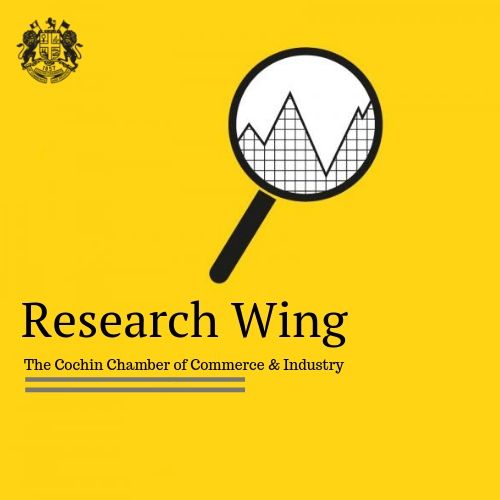


Chamber's Repository for all the Notifications and Guidelines pertaining to the COVID-19 outbreak, the resulting lockdown & unlock S.O.P.

Exclusive EXIM Statistics
Statistical Reports on Exports and Imports through the Cochin Port.
The Cochin Chamber of Commerce and Industry publishes statistical reports on Exports and Imports through the Cochin Port on a monthly basis followed by a Consolidated Annual Report at the end of each calendar year. The reports on exports are classified as commodity wise and pertain to the following commodities:
- Coffee
- Tea
- Spices
- Cashews
- Cotton Goods
- Seafood and
- Coir and coir products
Details on all other commodities that do not fall under the above-mentioned heads are carried as the ‘Miscellaneous Report’. Customized reports will also be available according to customers requirement.
We have several members in the export/import fraternity subscribing to these reports on a monthly basis and from the feedback received they are immensely benefited by the same.
We are confident that our reports will be of help to your Company in staying one step ahead of your competitors in business. A sample of the report is attached herewith for your reference. Also attached is the ‘Subscription Form’ to enable you to subscribe to the report should you want to do so.
Should you have any queries please feel free to contact Mr. T.M. Padbhanabhan (8921695456).
For more details, visit Export-Import Statistics







